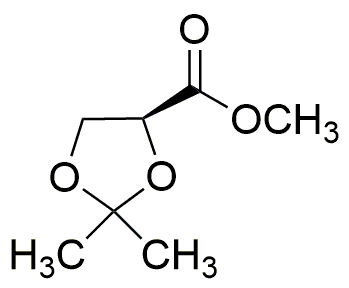(-)-Methyl (S)-2,2-dimethyl-1,3-dioxolane-4-carboxylate is widely utilized in research focused on:
- Synthetic Organic Chemistry: This compound serves as an important intermediate in the synthesis of various pharmaceuticals and agrochemicals, facilitating the creation of complex molecules.
- Chiral Auxiliary: Its chiral nature makes it valuable in asymmetric synthesis, helping researchers produce enantiomerically pure compounds, which are crucial in drug development.
- Polymer Chemistry: It can be used in the formulation of specialty polymers, enhancing properties such as flexibility and thermal stability, which are essential in materials science.
- Flavor and Fragrance Industry: The compound is also explored for its potential applications in creating flavoring agents and fragrances, offering unique sensory profiles.
- Biotechnology: In biocatalysis, it can act as a substrate or modifier, aiding in the development of more efficient enzymatic processes for producing bio-based products.
General Information
Properties
Safety and Regulations
Applications
(-)-Methyl (S)-2,2-dimethyl-1,3-dioxolane-4-carboxylate is widely utilized in research focused on:
- Synthetic Organic Chemistry: This compound serves as an important intermediate in the synthesis of various pharmaceuticals and agrochemicals, facilitating the creation of complex molecules.
- Chiral Auxiliary: Its chiral nature makes it valuable in asymmetric synthesis, helping researchers produce enantiomerically pure compounds, which are crucial in drug development.
- Polymer Chemistry: It can be used in the formulation of specialty polymers, enhancing properties such as flexibility and thermal stability, which are essential in materials science.
- Flavor and Fragrance Industry: The compound is also explored for its potential applications in creating flavoring agents and fragrances, offering unique sensory profiles.
- Biotechnology: In biocatalysis, it can act as a substrate or modifier, aiding in the development of more efficient enzymatic processes for producing bio-based products.
Documents
Safety Data Sheets (SDS)
The SDS provides comprehensive safety information on handling, storage, and disposal of the product.
Product Specification (PS)
The PS provides a comprehensive breakdown of the product’s properties, including chemical composition, physical state, purity, and storage requirements. It also details acceptable quality ranges and the product's intended applications.
Certificates of Analysis (COA)
Search for Certificates of Analysis (COA) by entering the products Lot Number. Lot and Batch Numbers can be found on a product’s label following the words ‘Lot’ or ‘Batch’.
*Catalog Number
*Lot Number
Certificates Of Origin (COO)
This COO confirms the country where the product was manufactured, and also details the materials and components used in it and whether it is derived from natural, synthetic, or other specific sources. This certificate may be required for customs, trade, and regulatory compliance.
*Catalog Number
*Lot Number
Safety Data Sheets (SDS)
The SDS provides comprehensive safety information on handling, storage, and disposal of the product.
DownloadProduct Specification (PS)
The PS provides a comprehensive breakdown of the product’s properties, including chemical composition, physical state, purity, and storage requirements. It also details acceptable quality ranges and the product's intended applications.
DownloadCertificates of Analysis (COA)
Search for Certificates of Analysis (COA) by entering the products Lot Number. Lot and Batch Numbers can be found on a product’s label following the words ‘Lot’ or ‘Batch’.
*Catalog Number
*Lot Number
Certificates Of Origin (COO)
This COO confirms the country where the product was manufactured, and also details the materials and components used in it and whether it is derived from natural, synthetic, or other specific sources. This certificate may be required for customs, trade, and regulatory compliance.


